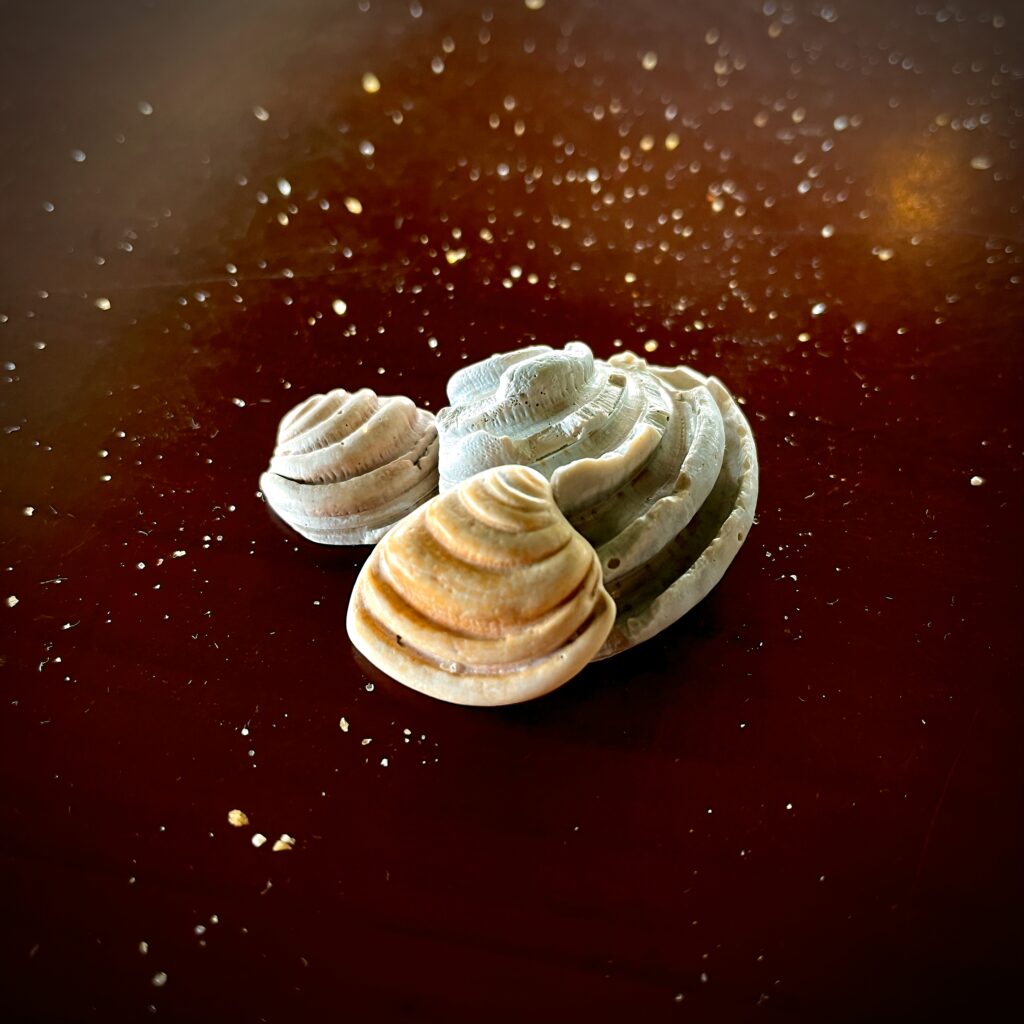Beachcombing for the Imperial Venus Clam Shell in South Carolina
Pawleys Island and its seashell collection
Pawleys Island is renowned for its exquisite seashell collection, and among the most coveted treasures is the Imperial Venus Clam Shell, AKA the Pawley’s Island Shell. Known for its distinct ridges and delicate pink hue, this shell has captured the imagination of beachcombers and collectors alike. Each shell tells a unique story of its journey through the tides, bearing witness to the ebb and flow of the ocean’s timeless dance.

Beyond their stunning beauty, these seashells also serve as crucial components of their local ecosystem. They provide homes for tiny sea creatures and contribute to the overall ecological balance of Pawleys Island’s shores. As visitors stroll along the pristine beaches, they are invited to marvel at these tiny natural wonders while gaining a deeper appreciation for the fragility and resilience of marine life.
From casual beachcombers to seasoned shell enthusiasts, Pawleys Island offers a unique opportunity to connect with nature through its awe-inspiring seashell collection. These shells not only serve as beautiful mementos but also hold a profound significance in preserving our planet’s delicate coastal ecosystems. With each discovery on this serene shore, visitors are reminded of nature’s boundless marvels and inspired to protect them for generations to come.
Keep in mind that the Pawley’s Island Shell and the Imperial Venus Clam are one in the same. Here is an interesting and comprehensive narrative about Pawley’s Island Shells: The Legend of the Pawley’s Island Shell.
History of the Imperial Venus Clam Shell
The history of the Imperial Venus Clam Shell is as fascinating as the shell itself. Dating back to ancient civilizations, these beautiful shells were often used as currency, decorative ornaments, and even religious symbols. In Roman times, they were associated with the goddess Venus, who was believed to have emerged from a giant clam shell. This association elevated the status of the Imperial Venus Clam Shell and made it a sought-after item among nobility and the upper class.
In more recent history, these exquisite shells have been treasured for their iridescent beauty and delicate patterns. They have been used in traditional crafts, jewelry making, and as decorative accents in homes around the world. The enduring allure of the Imperial Venus Clam/Pawley’s Island Shell speaks to its timeless appeal and its ability to transcend centuries of cultural changes. Whether displayed in a museum or adorning a piece of jewelry, each shell tells a story that spans generations and continents.
Characteristics of the Imperial Venus Clam Shell
The Imperial Venus clam shell, commonly found along the shores of Pawleys Island, is a marvel of nature with its distinctive characteristics. This unique shell features a smooth, glossy exterior with delicate ridges and concentric patterns that create an enchanting visual display. Its symmetrical shape and striking color variations ranging from deep purples to pearly whites make it a coveted find for both collectors and beachcombers alike.
One of the most fascinating aspects of the Imperial Venus clam shell is its resilience and adaptability to different environments. Despite facing various challenges in its habitat, this remarkable species has evolved to thrive in changing conditions, showcasing its ability to endure and flourish. Furthermore, the intricate growth lines on the shell provide evidence of the clam’s journey through life, offering glimpses into its age and experiences. These shells serve as enduring reminders of nature’s artistry and perseverance, captivating all who come across them along the sandy shores of Pawleys Island.
Where to find the Imperial Venus Clam Shell
The Imperial Venus Clam Shell, known for its exquisite beauty and rarity, can be found in the pristine beaches of Pawleys Island, South Carolina. These (very) elusive shells are often discovered at low tide, nestled among the sandy shores or hidden beneath the crystal-clear waters. The search for these extraordinary treasures requires patience and a keen eye, as they are often camouflaged among other seashells and debris.
Pawleys Island’s unique coastal environment provides the perfect habitat for the Imperial Venus Clam Shell to thrive. With its lush marshes and gently rolling waves, this barrier island offers a picturesque setting for beachcombers to seek out these coveted shells. Exploring the beaches during early mornings or late afternoons might enhance your chances of stumbling upon these elegant shells as they shimmer under the soft sunlight. Whether you’re an avid shell collector or a nature enthusiast, stumbling across an Imperial Venus Clam Shell along Pawleys Island’s shoreline is truly a remarkable experience worth cherishing.
Importance of preserving seashells in Pawleys Island
Preserving seashells in Pawleys Island holds a significance that transcends mere decorative appeal. These exquisite remnants of marine life not only serve as reminders of the island’s natural beauty, but also play a crucial role in preserving its delicate ecosystem. They provide homes and protection for various marine creatures, such as hermit crabs and mollusks, contributing to the island’s biodiversity. By safeguarding these seashells, we contribute to the conservation of the island’s environmental balance and sustain the livelihoods of its inhabitants.
Moreover, preserving seashells in Pawleys Island allows us to honor and celebrate the rich cultural history of this coastal community. For generations, these seashells have been integral parts of native rituals and artisanal practices, holding deep spiritual and artistic significance. By valuing and protecting these treasures, we pay homage to the traditions and heritage that have shaped Pawleys Island into a unique haven for both nature lovers and history enthusiasts. In doing so, we ensure that future generations can continue to cherish these shells as meaningful connections to their past.
Tips for collecting and preserving seashells
The joy of collecting seashells is an age-old pastime that gives us a glimpse into the captivating world beneath the waves. When embarking on this endeavor, be sure to respect nature by only taking empty shells and leaving living creatures untouched. To preserve your seashell collection, it’s vital to clean them gently with mild soap and water to remove any debris or lingering odors. Once dry, a light application of mineral oil can enhance their natural beauty and provide protection against drying out.
In addition to these preservation techniques, consider displaying your seashells in an aesthetically pleasing manner to showcase their unique shapes and colors. Mounting them in shadow boxes or arranging them in glass jars can become beautiful decor pieces that bring the tranquil essence of the ocean into your home. Lastly, always stay informed about local regulations when collecting seashells to ensure you’re respecting the environment and preserving its natural beauty for future generations.
Appreciating the beauty of nature’s treasures
As we conclude our exploration of the Imperial Venus Clam Shell, let’s take a moment to appreciate the beauty and wonder of nature’s treasures. The intricate patterns and delicate colors of seashells like the Imperial Venus Clam remind us of the artistry that exists within our natural world. These shells have a story to tell, a history that spans millions of years, shaped by the ebb and flow of ocean tides and currents.
By taking a moment to admire these seashells, we can connect with the environment around us in a deeper way. It’s a reminder to slow down and observe the small details that often go unnoticed. When we pause to appreciate the intricacies of nature’s treasures, we gain a renewed sense of awe for the world we inhabit. Let’s continue to cherish and protect these gifts from nature, allowing their beauty to inspire us in our everyday lives.
Wall Art Gallery
Photographs of Pawley’s Island Shells will soon be available in our gallery in our online galleries with Fine Art American and Pictorem.

